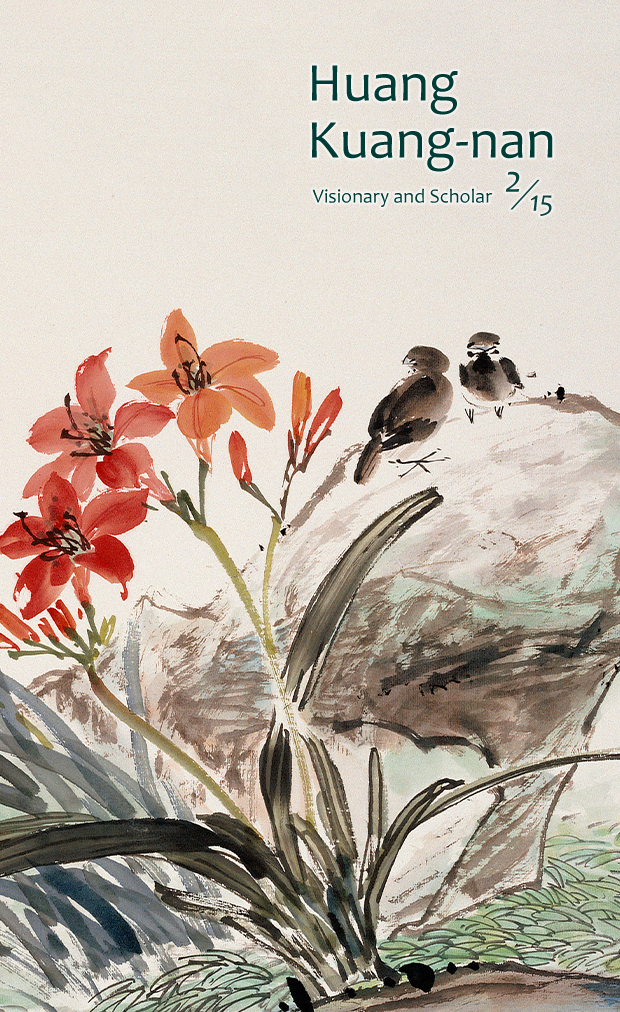

Huang Kuang-nan was born on Feb. 15, 1944, in Kaohsiung's Niaosong Township to a poor family. From an early age he helped on the farm and with household chores, doing laundry, preparing meals and looking after his younger brothers and sisters. Having grown up in the country, Huang developed keen observational skills about the world around him and a deep appreciation of nature inherited from his parents. When not working, he would spend his time drawing pictures in the sand using a branch as a brush.
At junior high school and teacher's college, Huang was inspired by Chiang Ching-jung and Pai Hsueh-hen, who helped him lay the foundations of his painting and calligraphy skill. In 1966, he entered the National Taiwan Academy of Arts (present-day National Taiwan University of Arts), where he studied Chinese painting in the fine arts department, and where his art was nurtured and guided by many renowned teachers, Jin Qin-bo and Fu Chuan-fu among them. He continued on to receive a BA in Chinese from National Kaohsiung Normal University (NKNU) and an MA from National Taiwan Normal University in Taipei, before returning to NKNU for a PhD.
Huang is an accomplished artist and scholar whose work has had a profound and far-reaching influence. In addition to his artistic achievements, particularly in Chinese ink painting, he has for many years contributed to the development of the arts and museums in Taiwan, serving as director of the Taipei Fine Arts Museum and then the National Museum of History, president of the National Taiwan University of Arts, minister without portfolio and a national policy advisor to the president. A true Renaissance man with dozens of published titles to his name, Huang is an erudite scholar of art history, fine arts and art theory, and a recipient of the Chinese Literary Award in Chinese painting, the Chunghsin Art Award in Chinese ink painting, the Chung Shan Arts Award and the Executive Yuan Government Information Office International Broadcasting Award, as well as the Order of Brilliant Star from the Presidential Office and a First Class Medal from the French Ministry of National Education.
His childhood spent working on the family farm, raising chickens and ducks, planting crops and pulling weeds gave Huang plenty of material from which to create ink paintings of birds, flowers and fruit brimming with life and a sense of familiarity.
Huang learned much about portraying living creatures from his time studying with Fu Chuan-fu, and his knowledge of nature, filtered through his Zen-inspired style, lend an inscrutable and placid feel to his work. Huang believes that art should reflect the artist's ideas, feelings, cultivation and moral principles, as well as remain intimately linked to their life experiences and childhood. This is why real scenes of village life in 1960s Taiwan are apparent in Huang's own work, depicting the fertile land and rustic nature of country life. At the same time, modernism allowed Huang to break free from convention in the treatment of his subject matter. He would often introduce Western art methods into traditional themes, gradually evolving a more abstract approach typified by vibrant colors and large expanses of empty space. One of the most characteristic features of Huang's work is the use of framing within a composition, giving a view of the outside world through windows with subjects contained in discreet panels. Huang blends geometric calligraphic strokes with ink painting principles, adding color to monochromatic elements and exploring textural effects and collage to create a conceptual world that draws in the viewer. Cheng Mao-cheng has said of Huang that he “takes the strongest elements of Western painting and combines it with Chinese painting to create a tranquil, idyllic style.”










